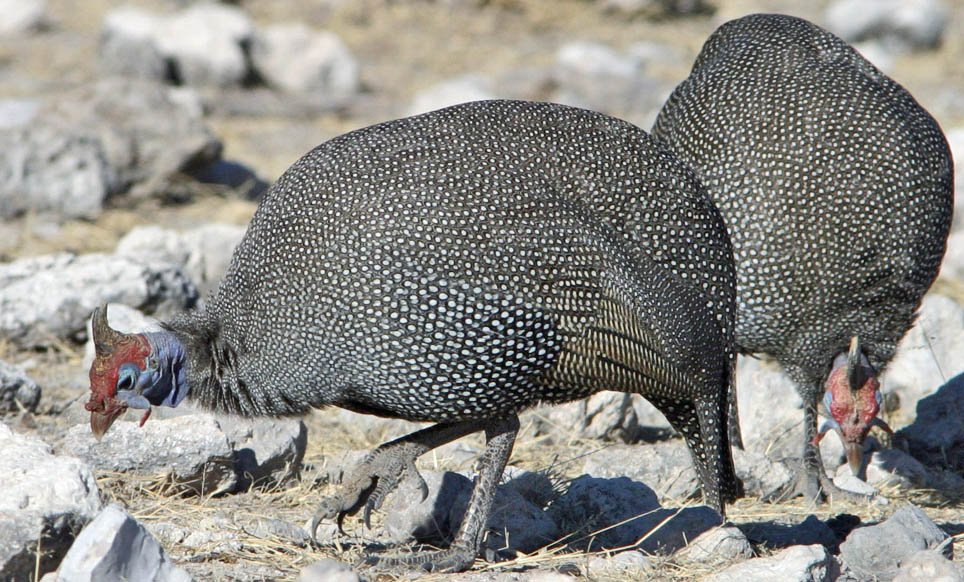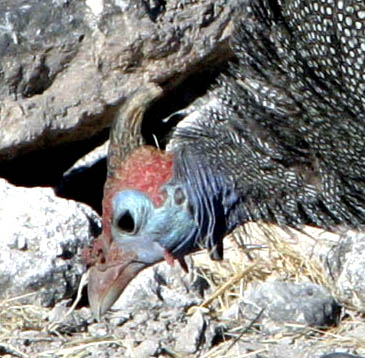
a web page by Don Roberson |
GUINEAFOWL Numididae |
|
At one time the Guineafowl were thought to be just a subfamily of a widely-expanded Phasianidae [Pheasants, Francolins, and allies] but molecular evidence suggests that they diverged long ago (e.g., Sibley & Ahlquist 1990). This most recent paper, using both DNA and fossil dating, suggests the divergence was at least 30 million years ago (Prum et al. 2015). Although there are fossils of ancient guineafowl in Mongolia — and the family may have originated in Asia (Martínez 1994) — today all the Numididae are native only to sub-Saharan Africa. |
 |
Guineafowl feathers have traditionally been highly prized as ornaments in some African tribe; later the feathers adorned women's hats in Europe. Certainly the feather patterns will be familiar to many. In these photos, notes also the horn-colored bony casque for which it is named in English; these are sometimes broken. Note also the absolutely huge feet, used as it forages on the ground for a wide variety of food. It prefers insects (grasshoppers, termites) where suitably abundant, but also consumes a variety of seeds, bulbs, roots and berries. |
In contrast to the few widespread guineafowl, the rest of the family are species that are much more local, scarce, and shy. Crested Guineafowl (left) occurs locally in western, eastern, and southern Africa, along woodland edges and in gallery forests, but I've only encountered it once despite several visits to Africa. Its congener, Plumed Guineafowl Guttera plumifera is a sedentary species of lowland forests in the Congo Basin, as is the elusive Black Guineafowl Agelastes niger. The remaining species — White-breasted Guineafowl A. meleagrides — is an endangered species, restricted to dense primary rainforest in west Africa in a narrow range that extends from eastern Sierra Leone to western Ghana. |
Photos: The Vulturine Guineafowl Acryllium vulturinum was in Samburu NP, Kenya, in Nov 1981. The Helmeted Guineafowl Numida meligris was photographed in Namibia in July 2005. The Crested Guineafowl Guttera pucherani was in Kruger NP, South Africa, in July 1996. All photos © Don Roberson; all rights reserved. Bibliographic note: There is no "family book" but a fine introduction to this family, with some fine photos, is in Martínez (1994). Literature cited:
|
 The
Numididae [Guineafowl] is a family of ground-dwelling gallinaceous
birds in Africa. They inhabit a wide variety of habitats from arid
thornscrub to humid Congo Basin rainforest. There are just six species
but they are assigned to four genera as many are quite distinctive. All
are bare-headed, although Vulturine Guineafowl (left) has a brownish patch of short feathers on the nape, and members of genus Guttera have a distinctive black crest.
The
Numididae [Guineafowl] is a family of ground-dwelling gallinaceous
birds in Africa. They inhabit a wide variety of habitats from arid
thornscrub to humid Congo Basin rainforest. There are just six species
but they are assigned to four genera as many are quite distinctive. All
are bare-headed, although Vulturine Guineafowl (left) has a brownish patch of short feathers on the nape, and members of genus Guttera have a distinctive black crest.  Certainly the best know species is Helmeted Guineafowl
(above and head detail, right). Except for dense tropical forests and
mountains, it is very widespread across sub-Saharan Africa. Over time
it has been subdivided in up to 30 subspecies but by the time of the Handbook of the Birds of the World
project started, this had been reduced to nine (Martínez 1994).
It has been domesticated locally and introduced as a domestic
commensal, or as a game bird, around the world. In shows up in murals
on ancient Egyptian pyramids back to the Fifth Dynasty of Egypt in 2400
BC. The Romans regularly kept it for food, but it was considered sacred
on some islands in the Aegean. It was imported widely to the New World
during the slave trade; feral populations arose in Cuba as early as the
16th century (Martínez 1994).
Certainly the best know species is Helmeted Guineafowl
(above and head detail, right). Except for dense tropical forests and
mountains, it is very widespread across sub-Saharan Africa. Over time
it has been subdivided in up to 30 subspecies but by the time of the Handbook of the Birds of the World
project started, this had been reduced to nine (Martínez 1994).
It has been domesticated locally and introduced as a domestic
commensal, or as a game bird, around the world. In shows up in murals
on ancient Egyptian pyramids back to the Fifth Dynasty of Egypt in 2400
BC. The Romans regularly kept it for food, but it was considered sacred
on some islands in the Aegean. It was imported widely to the New World
during the slave trade; feral populations arose in Cuba as early as the
16th century (Martínez 1994). 